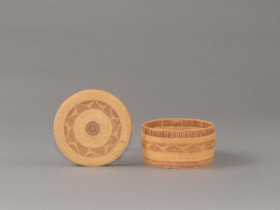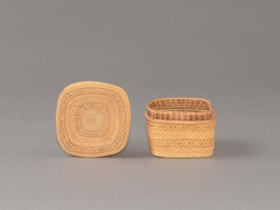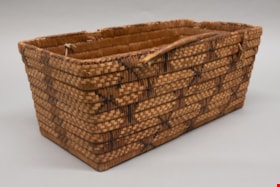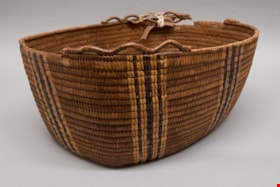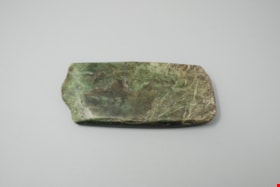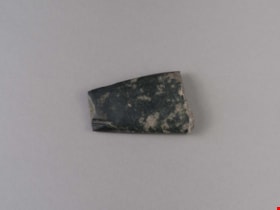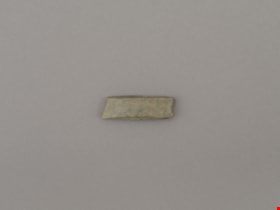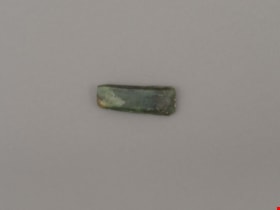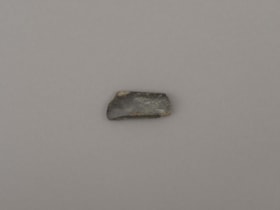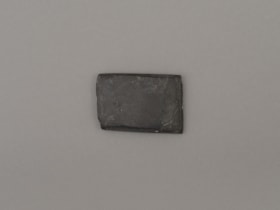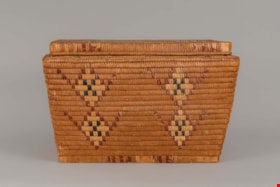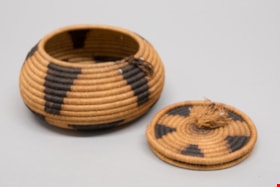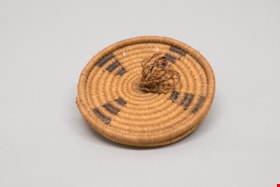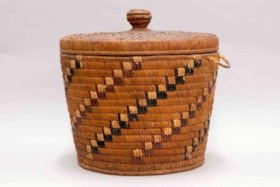More like 'Interview with Josephine Chow by Denise Fong February 7, 2020'
Narrow Results By
Subject
- Agriculture 1
- Agriculture - Farms 2
- Archeological Specimen 33
- Armament 18
- Arts 1
- Buildings - Commercial - Grocery Stores 1
- Buildings - Commercial - Restaurants 3
- Buildings - Commercial - Service Stations 1
- Buildings - Industrial - Saw Mills 1
- Buildings - Other 1
- Buildings - Religious - Monasteries 1
- Buildings - Religious - Mosques 1
Person / Organization
- Alpha Secondary School 1
- Arora, Maninder 1
- Babey, Beverley 1
- Binning, Dr. Sadhu 1
- Binning, Gurmaje Kaur 1
- Binning, Jagdish 1
- Binning, Jit Singh 1
- Brentwood Park School 1
- Brentwood Shopping Centre 1
- British Columbia Hydro and Power Authority 1
- British Columbia Organization to Fight Racism 1
- Burnaby Centennial '71 Committee 1
Interview with Norman Dowad
https://search.heritageburnaby.ca/link/museumdescription19638
- Repository
- Burnaby Village Museum
- Date
- [1890-2023] (interview content), interviewed 14 Aug. 2023
- Collection/Fonds
- Burnaby Village Museum fonds
- Description Level
- Item
- Physical Description
- 1 sound recording (wav) (61 min., 37 sec.) + 1 sound recording (mp3) (61 min., 37 sec.)
- Scope and Content
- Item consists of a recording of an oral history interview with Norman Dowad conducted by Burnaby Village Museum Registrar, Eric Damer on August 14, 2023. 00:00:00 – 00:14:38 Norm shares biographical information about himself and background information on the Dowad family. Norm conveys information …
- Repository
- Burnaby Village Museum
- Collection/Fonds
- Burnaby Village Museum fonds
- Series
- Museum Oral Histories series
- Subseries
- Many Voices Project Interviews subseries
- Description Level
- Item
- Physical Description
- 1 sound recording (wav) (61 min., 37 sec.) + 1 sound recording (mp3) (61 min., 37 sec.)
- Material Details
- Interviewer: Eric Damer Interviewee: Norman Dowad Location of Interview: Burnaby Village Museum Interview Date: August 14, 2023 Total Number of tracks: 1 Total Length of all Tracks: 01:14:37 Digital master recording (wav) was converted to mp3 for access on Heritage Burnaby
- Scope and Content
- Item consists of a recording of an oral history interview with Norman Dowad conducted by Burnaby Village Museum Registrar, Eric Damer on August 14, 2023. 00:00:00 – 00:14:38 Norm shares biographical information about himself and background information on the Dowad family. Norm conveys information about his grandfather Samuel Dowad's immigration to Canada and his father Wilfred Dowad's military service and successes as a property developer. 00:14:39 – 00:17:26 Norm provides background information on his mother’s side of the family. 00:17:27 – 00:31:36 Norm talks about his childhood, growing up in the Deer Lake neighbourhood, his early education in Burnaby and sports that he played. 00:31:37 – 00:39:59 Norm talks about his educational experiences attending Simon Fraser University, University of British Columbia and Osgoode Hall law school and information regarding his law career. 00:40:00 – 00:45:03 Norm reflects on his childhood growing up in Burnaby and on his experiences and relationships as a student and in his career as a lawyer. 00:45:04 – 01:01:37 Norm talks about his siblings and shares information about family property development projects as well as career and business successes. In closing he talks about research that he’s done through Archives Canada on his grandfather Sam Dowad and father Wilfred Dowad.
- History
- Interviewee biography: Norm Dowad was born in Burnaby, December 1948 to parents Wilfred “Wilf” (1925-2011) and Cherry Dowad. His father, Wilfred (1925-2011) was born in Winnipeg to parents Samuel “Sam” (Salim in Arabic) Esper Dowad (1895-1969) and Martha (Shaheen) Dowad (1894-1955). Sam and Martha Dowad were both born in a province of the Ottoman Empire which is now present day Lebanon. In 1912, while trying to immigrate to Canada, several of Sam’s relatives including his mother died tragically as steerage passengers on the ill fated Titanic. In 1913, at the age of 18 years, Sam immigrated to Canada to join other family members who'd already arrived here safely. As a new immigrant in Canada, Sam worked with other Labanese immigrants in Saskatchewan, Manitoba and the United States. In December 1921, Sam's wife, Martha immigrated to Canada arriving by ship in St. John, New Brunswick. Sam and Martha established their home in Winnipeg where they began to start a family. Their first two children died in infancy and son Wilfred was born in 1925 and daughter Kathleen was born in 1926. While living in Winnipeg, Sam worked as a grocer and in the 1930’s he got work as a farmer in a nearby town. In 1943, Wilf joined the Royal Canadian Naval Volunteer Reserve (RCVNR) and served as a gunner on merchant ships during World War II. In 1945, while Wilf was away serving, his parents, Sam and Martha moved to Burnaby. After discharge in 1945, Wilf joined his parents in Burnaby, began working at Fraser Mills and commenced his studies in construction and drafting. In 1949, with his father’s help Wilf acquired a lot next door to his parents’ home and built his first apartment block. After Martha died in 1954, Sam moved to Kelowna where he bought an orchard. Sam remarried in 1957 to Naomi “Mamie” (David) Dowad (1899-1978) who was also from a Lebanese family. Sam and Mamie lived in Kelowna until the mid 1960s when they moved to White Rock. While living in Burnaby, Wilf met and married Cherry Piggott and the couple had six children; Norm, Bruce, Michael, Kathie, Phil and Tom. In 1955, Wilfred Dowad established "W. Dowad Ltd." and over the years he was successful in developing and subdividing land to build housing and commercial developments in Burnaby, New Westminster and Vancouver. Wilf was the first president of the Burnaby Winter club and was an active member of the Junior Chamber of Commerce holding office at the local, provincial and national level. In 1970, Wilf purchased 238 acres of land bordering the Sḵwx̱wú7mesh River and relocated there the following year. While living in Sḵwx̱wú7mesh, Wilf became actively engaged in local business and community affairs. Wilf was later remarried to Grethe Dowad and he died in Sḵwx̱wú7mesh in 2011.Wilf's six children are the sole owners of "W.Dowad Ltd." and his daughter, Kathie Smillie is the president and CEO. While growing up in Burnaby, Norm Dowad attended Schou Street School, Douglas Road School, Kensington School and graduated from Burnaby Central Secondary School. Following graduation from high school, Norm attended Simon Fraser University for one year, travelled in Europe, attended University of British Columbia and obtained his law degree from Osgoode Hall at York University. Norman has been practicing law for 49 years and has his own law practice that he operates out of Vancouver. Interviewer biography: Eric Damer is a Burnaby Village Museum Interpreter, Museum Registrar, Researcher and Blacksmith. Eric pounded hot steel for the first time in 1977 in junior high. Fifteen years later, he joined Burnaby Village Museum where he has smithed for three decades. He also provides historical research for museum exhibits and special projects. Outside the museum, Eric is a social historian with a special interest in educational history.
- Creator
- Burnaby Village Museum
- Subjects
- Agriculture - Farms
- Education
- Persons - South Asian Canadians
- Migration
- Sports
- Sports - Football
- Wars - World War, 1939-1945
- Names
- Dowad, Norman W. "Norm"
- Dowad, Samuel Esper "Sam"
- Dowad, Wilfred "Wilf"
- Dowad, Naomi "Mamie" David
- Dowad, Martha Elias Shaheen
- Dowad, Kathleen "Kay"
- Rideout, Dr. John Anthony
- Burnaby Central Secondary School
- Douglas Road School
- W. Dowad Limited
- Responsibility
- Damer, Eric
- Geographic Access
- Buckingham Avenue
- Deer Lake
- Street Address
- 5533 Buckingham Avenue
- Accession Code
- BV023.16.16
- Access Restriction
- No restrictions
- Reproduction Restriction
- No known restrictions
- Date
- [1890-2023] (interview content), interviewed 14 Aug. 2023
- Media Type
- Sound Recording
- Historic Neighbourhood
- Burnaby Lake (Historic Neighbourhood)
- Planning Study Area
- Morley-Buckingham Area
- Notes
- Title based on contents of item
- Transcription available
Documents
Audio Tracks
Interview with Norman Dowad, [1890-2023] (interview content), interviewed 14 Aug. 2023
Interview with Norman Dowad, [1890-2023] (interview content), interviewed 14 Aug. 2023
https://search.heritageburnaby.ca/media/hpo/_Data/_BVM_Sound_Recordings/Oral_Histories/2023_0016_0016_002.mp3Interview with Honourable Raj Chouhan
https://search.heritageburnaby.ca/link/museumdescription19349
- Repository
- Burnaby Village Museum
- Date
- [1957-2022] (interview content), interviewed 2 Dec. 2022
- Collection/Fonds
- Burnaby Village Museum fonds
- Description Level
- Item
- Physical Description
- 1 sound recording (wav) + 1 sound recording (mp3) (49 min., 21 sec.)
- Scope and Content
- Item consists of an oral history interview with Honourable Raj Chouhan conducted by Burnaby Village Museum Assistant Curator, Kate Petrusa. Raj Chouhan shares his ancestral background and personal experiences immigrating to Canada from India in 1973 and living and working in Canada as an immigrant…
- Repository
- Burnaby Village Museum
- Collection/Fonds
- Burnaby Village Museum fonds
- Series
- Museum Oral Histories series
- Description Level
- Item
- Physical Description
- 1 sound recording (wav) + 1 sound recording (mp3) (49 min., 21 sec.)
- Material Details
- Interviewer: Kate Petrusa Interviewee: Honourable Raj Chouhan Location of Interview: Residence of Honourable Raj Chouhan Interview Date: December 2, 2022 Total Number of tracks: 1 Total Length of all Tracks: (00:49:21) Digital master recording (wav) was converted to mp3 for access on Heritage Burnaby
- Scope and Content
- Item consists of an oral history interview with Honourable Raj Chouhan conducted by Burnaby Village Museum Assistant Curator, Kate Petrusa. Raj Chouhan shares his ancestral background and personal experiences immigrating to Canada from India in 1973 and living and working in Canada as an immigrant and the organizations that he became involved with. Honourable Raj Chouhan recalls how he arrived in Burnaby with his family in 1973 and that his family worked in farming. Chouhan imparts his first hand experiences as a new immigrant working as a labourer in the farming industry and describes the unsafe and unfair working conditions that he and migrant workers faced. Chouhan conveys how this experience lead him to become an activist for better working conditions for migrant workers. This lead Chouhan and others to form the Canadian Farm Workers Union in 1980. Chouhan recollects his experiences flying from India to Canada with his wife, his first impressions after arriving in Vancouver and driving to Burnaby and what he brought with him. Chouhan explains his connections to Burnaby. Members of Chouhan's wife's family immgrated to Canada in 1957 and his wife and her three brothers joined them in 1970. Chouhan's father in law, Hardial Singh Grewal immigrated in 1957 and became president of the Sikh temple in New Westminster. Hardial Singh Grewal worked in a lumber mill in Vancouver and eventually bought a house in Burnaby. Chouhan married to his wife at the Sikh temple in New Westminster and lived in Burnaby for a period before moving to New Westminster where they could find more affordable housing. Chouhan shares that he first worked as a farm labourer in Abbotsford and then found a job in the sawmill which paid more. Chouhan describes the extreme racism and discrimination that he and other immigrants faced which lead to the formation of the British Columbia Organization to Fight Racism under the leadership of Dr. Hari Prakash Sharma. Chouhan describes this organization that he was a part of and the Canadian Farm Workers Union that were both formed in Burnaby. Chouhan shares that he moved to Victoria in 1988 to serve on the Hospital Employee's Union and moved back to the mainland in 1993 and returned to Burnaby in 2001. Chouhan reflects on the history of South Asian immigration in Canada, how many of the migrants settled in the lower mainland including Burnaby, New Westminster and Vancouver establishing temples in Vancouver and New Westminster which became the centre for the South Asian community. He conveys how earlier occupations were limited to farming and millwork and how over time employment opportunities and education have broadened but there is still work to do. He imparts how second generation Canadians’ experiences differ from first generations providing examples of his own daughters’ and the occupations that they are working in. Chouhan provides his insights into the South Asian Canadian experience imparting “We make history every day and that history needs to be recorded and learned from.."... “People from different communities, different backgrounds who lived in Burnaby have contributed so much and South Asians are just like another community and participated in all aspects of social life, cultural, religious, economy. I'm so proud of our community, our forefathers who had that vision to fight for our rights. I'm inspired by people who struggled so much to gain basic rights, like the right to vote". Chouhan refers to these first immigrants as “Gadri Babbas” “revolutionary old people” who were also the main motivation that lead to India becoming a free country in 1947 and for fighting for basic rights here in Canada and how they made their contributions for future generations. Chouhan expresses what he imparts to students “Do not forget your past... if you remember your past then you are much more knowledgeable. Then we know what we need for the future. If we don't know the past, we don't know what the future is going to be like. To make a better future, you have to learn from the past and improve".
- History
- Interviewee biography: Honourable Raj Chouhan was born in the city of Ludhiana in the Province of Punjab in India and immigrated to Canada in 1973. After arriving in Canada, Raj's family settled in Burnaby. Raj grew up in Burnaby and attended schoool. Honourable Raj Chouhan was elected to the Legislative Assembly of British Columbia as the MLA for Burnaby-Edmonds in 2005 and was re-elected in 2009, 2013, 2017 and 2020. He was elected Speaker of the Legislative Assembly on December 7, 2020. Honourable Chouhan is the founding president of the Canadian Farmworkers Union and the British Columbia Organization to Fight Racism and has served as a director of the Hospital Employees' Union, the Labour Relations Board of B.C. and the Arbitration Bureau of B.C. Honourable Chouhan has also served as the Vice President of B.C. Human Rights Defenders since 2003 and has taught courses in Human Rights, the B.C. Labour Code and Collective Bargaining since 1987. Interviewer biography: Kate Petrusa is the Assistant Curator at the Burnaby Village Museum. In her role, she manages all aspects of the collection – including caring for physical artifacts and making their digital counterpart accessible. Before coming to Burnaby Village Museum in 2019, Kate has worked at several Museums around the Lower Mainland as a Curator and contractor since 2013.
- Creator
- Burnaby Village Museum
- Subjects
- Persons - South Asian Canadians
- Social Issues
- Social Issues - Racism
- Occupations - Agricultural Labourers
- Migration
- Organizations - Unions
- Rights
- Rights - Human Rights
- Agriculture
- Agriculture - Farms
- Government - Provincial Government
- Government
- Names
- Chouhan, Raj
- British Columbia Organization to Fight Racism
- Sharma, Dr. Hari Prakash
- Grewal, Hardial Singh
- Canadian Farmworkers Union
- Hospital Employees Union
- Khalsa Diwan Society
- Responsibility
- Petrusa, Kate
- Accession Code
- BV022.29.4
- Access Restriction
- No restrictions
- Reproduction Restriction
- No known restrictions
- Date
- [1957-2022] (interview content), interviewed 2 Dec. 2022
- Media Type
- Sound Recording
- Notes
- Title based on contents of item
- Transcription available on Heritage Burnaby
Documents
Audio Tracks
Interview with Honourable Raj Chouhan, [1957-2022] (interview content), interviewed 2 Dec. 2022
Interview with Honourable Raj Chouhan, [1957-2022] (interview content), interviewed 2 Dec. 2022
https://search.heritageburnaby.ca/media/hpo/_Data/_BVM_Sound_Recordings/Oral_Histories/2022_0029_0004_002.mp3Interview with Harry Toy, Beverley Babey and Christina Toy
https://search.heritageburnaby.ca/link/museumdescription20285
- Repository
- Burnaby Village Museum
- Date
- [1905-2023] (interview content), interviewed 25 Sep. 2023
- Collection/Fonds
- Burnaby Village Museum fonds
- Description Level
- Item
- Physical Description
- 1 sound recordings (wav) (121min., 14 sec.) + 1 sound recording (mp3) (121 min., 13 sec.)
- Scope and Content
- Item consists of a recording of an oral history interview with Harry Toy, Beverley Babey and Christina Toy conducted by Burnaby Village Museum researcher Denise Fong on September 25, 2023. The interview is divided into four sections: early life of Harry Toy, the Canada Way Food Market, the Fraser M…
- Repository
- Burnaby Village Museum
- Collection/Fonds
- Burnaby Village Museum fonds
- Series
- Museum Oral Histories series
- Subseries
- Many Voices Project Interviews subseries
- Description Level
- Item
- Physical Description
- 1 sound recordings (wav) (121min., 14 sec.) + 1 sound recording (mp3) (121 min., 13 sec.)
- Material Details
- Interviewer: Denise Fong Interviewees: Harry Toy, Beverley Babey and Christina Toy Location of Interview: Residence of Harry Toy Interview Date: September 25, 2023 Total Number of tracks: 1 Total Length of all Tracks: 02:01:13 Digital master recording (wav) was converted to mp3 for access on Heritage Burnaby
- Scope and Content
- Item consists of a recording of an oral history interview with Harry Toy, Beverley Babey and Christina Toy conducted by Burnaby Village Museum researcher Denise Fong on September 25, 2023. The interview is divided into four sections: early life of Harry Toy, the Canada Way Food Market, the Fraser Merchants’ Association and Harry's daughters, Beverley Babey and Christina Toy's memories of growing up in Burnaby. 00:00:00 – 00:23:53 Harry Toy shares biographical information about himself and his ancestors. Harry provides information about his migration to Canada and his life in Manitoba, attending school, working at the family restaurant and teaching high school. 00:23:53 – 00:41:16 Harry talks about moving his family to Burnaby and his experiences owning and operating the Canada Way Food Market. 00:41:17 – 00:54:19 Harry talks about his involvement with the Fraser Merchants Association (FMA) and provides some history about the organization. 00:54:20 – 1:22:44 Harry talks about running the Canada Way Food Market and the alterations that he made to the store over the years. Harry and his daughters comment as they look through photographs of Harry and his store and the Fraser Merchants Association. 1:22:45 – 2:01:14 Beverley and Christina talk about their early childhood in Manitoba and growing up in Burnaby. They recall what it was like growing up and working in the family owned store.
- History
- Interviewee biography: Harry Wee Koon Toy was born in February 9, 1936 in Taikong, Toisan county, Guangdong, China. Harry's father William Toy came to Canada in the early 1920s when he was ten years old. Harry arrived in Vancouver, Canada on September 9, 1950. After staying in Vancouver for one night, he joined his father in Neepawa, Manitoba where the family operated a cafe business (Royal Cafe). Harry grew up in Neepawa and graduated from the University of Manitoba and teacher's college. He became a high school teacher and worked at schools in Minnedosa and Gladstone, Manitoba teaching various subjects including, science, business, geography, history and physical education. Harry and his wife, had three daughters, Melinda, Beverley and Christina who were all born in Neepawa. When the family decided to move to the west coast, Harry was introduced to the grocery store business through an uncle who was a store operator. Around 1970, Harry purchased a grocery store at 4694 Canada Way in Burnaby which he named "Canada Way Food Market" and Harry and his daughters made their home at the back of the store. Harry owned and operated the store for approximately 40 years between 1970 and 2010. Around 1986, Harry purchased the butcher shop next door (4692 Canada Way) which was no longer in operation, expanding his store and adding a second storey to use a residence. Harry's children helped him operate the store throughout their childhood. In the early 1970s, corner stores were threatened by the spread of small chain-operated convenience stories from Eastern Canada to Vancouver. Formed in April 1972, the Fraser Merchants’ Association was established to protect the rights of corner store operators. With no paid legal help, the association was incorporated in Victoria, BC for the cost of 56 cents. The benefits of being a member of the association included warehouse and group purchasing, common advertising and other advantages of being part of an association. Founded by Gary Lee Ling and five others, Fraser Merchants’ Association’s first member was Graham Grocery. By 1978, the association represented over 200 corner stores in the Lower Mainland (Delta, Surrey, White Rock, Langley, Coquitlam, and New Westminster) and Fraser Valley. The association remained active into the 1980s and 1990s. Harry has served as President of the Fraser Merchants' Association from 1992 to present. Interviewer biography: Denise Fong is a historical researcher at Burnaby Village Museum. She has degrees in Anthropology (BA) and Archaeology (MA), and is completing her doctoral degree at UBC in Interdisciplinary Studies. Her primary research interests are in Chinese Canadian history and critical heritage studies. She is the co-curator of BVM’s “Across the Pacific” exhibition, and the Museum of Vancouver’s “A Seat at the Table – Chinese Immigration and British Columbia”.
- Creator
- Burnaby Village Museum
- Subjects
- Education
- Migration
- Occupations - Teachers
- Occupations - Grocers
- Organizations
- Organizations - Business Associations
- Persons - Chinese Canadians
- Social Issues
- Social Issues - Racism
- Buildings - Commercial - Grocery Stores
- Names
- Toy, Christina
- Toy, Harry Wee Koon "Harry"
- Babey, Beverley
- Canada Way Food Market
- Fraser Merchants' Association
- Responsibility
- Fong, Denise
- Geographic Access
- Canada Way
- Street Address
- 4694 Canada Way
- Accession Code
- BV023.16.19
- Access Restriction
- No restrictions
- Reproduction Restriction
- No known restrictions
- Date
- [1905-2023] (interview content), interviewed 25 Sep. 2023
- Media Type
- Sound Recording
- Related Material
- See also: BV023.25 - Harry Toy fonds
- Notes
- Title based on contents of item
- Transcription available
Documents
Audio Tracks
Interview with Harry Toy, Beverley Babey and Christina Toy, [1905-2023] (interview content), interviewed 25 Sep. 2023
Interview with Harry Toy, Beverley Babey and Christina Toy, [1905-2023] (interview content), interviewed 25 Sep. 2023
https://search.heritageburnaby.ca/media/hpo/_Data/_BVM_Sound_Recordings/Oral_Histories/2023_0016_0019_002.mp3Interview with Richard Liu
https://search.heritageburnaby.ca/link/museumdescription20283
- Repository
- Burnaby Village Museum
- Date
- [1936-2023] (interview content), interviewed 11 Sep. 2023
- Collection/Fonds
- Burnaby Village Museum fonds
- Description Level
- Item
- Physical Description
- 3 sound recordings (wav) (153 min., 33 sec.) + 1 sound recording (mp3) (152 min., 59 sec.)
- Scope and Content
- Item consists of a recording of an oral history interview with Richard Liu conducted by Burnaby Village Museum researcher Denise Fong on September 11, 2023. 00:00:00 – 00:26:39 Richard Liu shares biographical information about himself and his family in China. He talks about his family being forced…
- Repository
- Burnaby Village Museum
- Collection/Fonds
- Burnaby Village Museum fonds
- Series
- Museum Oral Histories series
- Subseries
- Many Voices Project Interviews subseries
- Description Level
- Item
- Physical Description
- 3 sound recordings (wav) (153 min., 33 sec.) + 1 sound recording (mp3) (152 min., 59 sec.)
- Material Details
- Interviewer: Denise Fong Interviewee: Richard Liu Location of Interview: Love farmhouse at Burnaby Village Museum Interview Date: September 11, 2023 Total Number of tracks: 3 Total Length of all Tracks: 02:33:33 Digital master recordings (wav) were recorded onto three separate audio tracks, edited and merged together into one track and converted to mp3 for access on Heritage Burnaby
- Scope and Content
- Item consists of a recording of an oral history interview with Richard Liu conducted by Burnaby Village Museum researcher Denise Fong on September 11, 2023. 00:00:00 – 00:26:39 Richard Liu shares biographical information about himself and his family in China. He talks about his family being forced out by the communist regime in the early ‘50s and their experiences immigrating to Hong Kong, Europe and Canada. 00:26:40 - 00:32:59 Richard talks about his parents’ experiences living in Toronto, Victoria and Burnaby and shares some of his father’s business accomplishments including establishing the first direct flight to Beijing in 1987 and the first sister city between China and Canada. 00:33:00 – 01:13:59 Richard talks about living in Burnaby and his educational experiences at Thomas More Collegiate. He recalls his experience of travelling to North Korea in 1988 and being a student at Peking University in Beijing during the student-led demonstrations in Tiananmen Square and the Tiananmen Square massacre in 1989. 01:14:00 – 01:26:16 Richard talks about his education and reflects on how his experiences in Beijing influenced his education and career choices including working in the Prime Minister’s office on trade missions to China and talks about the importance of leaning French. 01:26:17 – 01:48:35 Richard shares his memories and experiences of; being on the Canadian Paralympic Committee during the 2008 Olympic and Paralympic Games in China, supporting Rick Hansen during his visit to China for the 25th anniversary of the Man in Motion World Tour and working with Team Canada in China for the 2022 Olympic Games. 01:48:36 – 01:52:22 Richard talks about his life in Burnaby after moving back from China in 2014 and the changes he’s noticed since being away. Richard talks about his involvement with St. John Ambulance, his role as the Honorary Brigade Division President and his role as Heritage Commissioner for the City of Burnaby. 02:14:32 – 02:29:27 Richard talks about his investiture to the Order of Saint John in 2023 and reflects on the accomplishments of his great uncle Dr. Shin-Shu Liu (China’s first Ambassador to Canada). 02:29:28 – 02:32:59 In closing Richard imparts some words of wisdom for future generations.
- History
- Interviewee biography: Richard N. Liu was born in 1970 in Toronto and raised in British Columbia. Richard's family has distinguished Canada-China ties for three generations. His Great-Uncle, Dr. Liu Shih-shun, was China's first Ambassador to Canada in 1942 and his father, Dr. Liu Dun-ren, built relations in education, culture and tourism for three decades including establishing the first Twin Sister City between Canada and China with Victoria and Suzhou in 1980. Richard's maternal great-grandfather, Dr. Wu Han-chi (1872-1913) played an active role in uprisings that shaped the future of modern China, was an elected member of the lower house of the first formal parliament in 1913 and was assassinated on political grounds. Dr. Wu's daughter, Dr. Wu Chi-mei served Dr. Sun Yat-sen, was elected as a Guangzhou City Councillor and visited Vancouver in 1929 and 1932. After graduating from St. Thomas More Collegiate in Vancouver, Richard Liu moved to China to begin his studies at Peking University but in 1989, following the Tiananmen Square protest and massacre, he was evacuated from China and returned to Canada. While back in Canada, Liu completed a BA in East Asian Studies from the University of British Columbia and in 1993, he returned to China to continue his Chinese studies at Peking University and continued to live in China for twenty years. In 2008, Richard worked as Team Canada’s Attaché for the Paralympic Summer Games that took place in Beijing. In 2014, Liu returned to Canada and made his home in Burnaby with his wife and two children. In 2022, Liu returned to Beijing to serve as Mission Staff member for Team Canada at the Winter Olympics. Richard has also played a leading role with the Terry Fox Run, Special Olympics and Rick Hansen's visit to Beijing in 2011. Liu’s areas of expertize include; public relations, diplomacy, major events organization and education. Liu works as an advisor in East Asian Studies at the University of British Columbia and is a MA Candidate at Peking University. Richard founded the Canadian Alumni Network that connects over 16,000 alumni in China who’ve attended Canada's post-secondary institutions. Liu has been a commissioner with the City of Burnaby’s Heritage Commission (2018-2023) and sits on various boards advising companies and organizations on a variety of sectors pertaining to Asia. In 2019, Liu was appointed the Honorary Brigade Division President for St. John Ambulance and was among 13 UBC Alumni to be recognized and awarded the 2018-2019 UBC Alumni Builder Award “For his service, dedication, and contribution to UBC and its alumni community. For his long record of service fostering connections with alumni and students in Beijing and Asia as well as dedication to mentoring students in the Faculty of Arts.” On June 24 2023, Richard was formally invested into the Order of St. John, one of five national orders in the Canadian Honours System. Interviewer biography: Denise Fong is a historical researcher at Burnaby Village Museum. She has degrees in Anthropology (BA) and Archaeology (MA), and is completing her doctoral degree at UBC in Interdisciplinary Studies. Her primary research interests are in Chinese Canadian history and critical heritage studies. She is the co-curator of BVM’s “Across the Pacific” exhibition, and the Museum of Vancouver’s “A Seat at the Table – Chinese Immigration and British Columbia”.
- Creator
- Burnaby Village Museum
- Subjects
- Persons - Chinese Canadians
- Migration
- Officials
- Education
- Protests and Demonstrations
- Social Issues
- Social Issues - Racism
- Sports
- Travel
- Religions - Christianity
- Names
- Canadian Paralympic Committee
- Chak, Dr. Po Tin
- Chinese Canadian Historical Society of BC
- Liu, Richard N.
- Liu, Dr. Dun-ren
- Liu, Dr. Shih-Shun
- Gigli, Beniamino
- Hansen, Richard Marvin "Rick"
- Olympic Games
- Paralympic Games
- Peking University
- St. John Ambulance
- St. Thomas More Collegiate
- Tiananmen Square
- University of British Columbia
- Responsibility
- Fong, Denise
- Accession Code
- BV023.16.17
- Access Restriction
- No restrictions
- Reproduction Restriction
- No known restrictions
- Date
- [1936-2023] (interview content), interviewed 11 Sep. 2023
- Media Type
- Sound Recording
- Notes
- Title based on contents of item
- transcription available
Documents
Audio Tracks
Interview with Richard Liu, [1936-2023] (interview content), interviewed 11 Sep. 2023
Interview with Richard Liu, [1936-2023] (interview content), interviewed 11 Sep. 2023
https://search.heritageburnaby.ca/media/hpo/_Data/_BVM_Sound_Recordings/Oral_Histories/2023_0016_0017_004.mp3basket
https://search.heritageburnaby.ca/link/museumartifact84019
- Repository
- Burnaby Village Museum
- Accession Code
- BV014.9.1
- Description
- This basket is woven using the wrapped twining method and is made of swamp grass. The designs were made using aniline dyes and are badly faded; original colours still visible on the inside of lid and basket. The weave on this basket is very finely done. The basket and lid are decorated with bird motifs. Originally birds were yellow on a purple background. The lid has a drop edge that fits over a lip around the top edge of the basket. It is decorated in concentric circles with a dark spot in the centre. The spot includes black as well as the wine colour. The outside is faded to a light brown colour. Nuu-chah-nulth
- Object History
- The basket was acquired in Victoria in the 1930s before the family moved to Vancouver.
- Country Made
- Canada
- Province Made
- British Columbia
- Culture
- Nuu-Chah-Nulth
Images
Documents
basket
https://search.heritageburnaby.ca/link/museumartifact84020
- Repository
- Burnaby Village Museum
- Accession Code
- BV014.9.2
- Description
- Basket with red cedar bark base and warps and swamp grass wefts. The base is done in checker weave, while the walls and lid are done using wrapped twining. The base of the basket is secured with two strand twining and then the warps were split and smaller rows of two strand twining follow. The edge of the base is distinguished by one row of three strand twining, which creates a noticeable break in the pattern, before the wrapped twining begins for the walls. Designs, consisting of horizontal stripes, were made using analine dyes, which are extremely light sensitive. Colours are preserved on inside of basket, where light exposure has been much lower. Originally red and black stripes. Nuu-chah-nulth
- Object History
- The basket was acquired in Victoria in the 1930s before the family moved to Vancouver.
- Country Made
- Canada
- Province Made
- British Columbia
- Culture
- Nuu-Chah-Nulth
Images
Documents
carrying basket
https://search.heritageburnaby.ca/link/museumartifact80210
- Repository
- Burnaby Village Museum
- Accession Code
- BV009.1.1
- Description
- Rectangular coiled cedar root basket with cedar slat foundation and walls that flare slightly towards rim. Decorated in beaded designs of cattail grass and black dyed cherry bark. Darker elements arranged in a butterfly design. Butterflies are said to represent everlasting life by Stó:lō and Nlaka’pamux basket makers. Overcast handles sewn to basket with leather ties. One has been repaired with string. Finished with a braided rim. Triangular shaped stitches attach base to walls of basket. Interior Salish: Stl’atl’imx?
- Object History
- Basket, ca. 1895-1910, from the collection of the L. Claude Hill family, who owned the property that became the Burnaby Village Museum. According to the Hill family, L. Claude's wife Anne Sarah Hill (nee Kendrick) traded blankets for baskets, although it is not known if this particular basket was obtained in this manner. Indigenous people travelled the trail that crossed Deer Lake Brook (Douglas Road / Canada Way).
- Measurements
- Measurements: width 24 cm and length 44 cm and depth 18 cm. All measured from top edge to outside.
- Country Made
- Canada
- Province Made
- British Columbia
- School/Style
- Coast Salish
- Culture
- Stl’atl’imx
Images
Documents
work basket
https://search.heritageburnaby.ca/link/museumartifact80211
- Repository
- Burnaby Village Museum
- Accession Code
- BV009.1.2
- Description
- Oval shaped coiled cedar root basket with cedar slat foundation. Overcast rim with remnants of a loopwork border. Decorated with vertical stripes of imbricated designs in canary grass and black dyed cherry bark. Cherry bark can be distinguished by the small eyes in the surface of the bark. If the basket maker is skilled the bark has a shiny appearance, if it has not been scraped properly it has a greyish tinge. Canary grass is differentiated from cattail and bear grass by its shiny appearance according to a Stó:lō/Stl’atl’imx elder and basket maker from Mount Currie, who was married into Upper Sḵwx̱wú7mesh.
- Object History
- Basket, ca. 1895-1910, from the collection of the L. Claude Hill family, who owned the property that became the Burnaby Village Museum. According to the Hill family, L. Claude's wife Anne Sarah Hill (nee Kendrick) traded blankets for baskets, although it is not known if this particular basket was obtained in this manner. Indigenous people travelled the trail that crossed Deer Lake Brook (Douglas Road / Canada Way).
- Measurements
- Measurements: width 31.5 cm and length 51.5 cm and depth 19.5 cm all measured from top edge to outside of basket, not including trim.
- Country Made
- Canada
- Province Made
- British Columbia
- School/Style
- Coast Salish
- Culture
- First Nations
Images
Documents
adze blade
https://search.heritageburnaby.ca/link/museumartifact44868
- Repository
- Burnaby Village Museum
- Accession Code
- BV002.57.19
- Description
- Nephrite adze blade; chipped on one end; rectangular shaped.
- Object History
- The donor inherited this artifact from his mother, Katherine Maude (Kitty) Peers, who inherited them from her father, Louis Claude Hill. The artifacts were found on his farm, Brookfield Farm, at Douglas Road and Sperling Avenue (now site of Burnaby Village Museum).
- Nephrite is found in the Fraser Canyon
- Culture Phase: Possibly Locarno Beach phase (3520-2200 Before Present) or Marpole (400BC - 400AD)
- Historic Neighbourhood
- Burnaby Lake (Historic Neighbourhood)
Images
Documents
adze blade
https://search.heritageburnaby.ca/link/museumartifact44870
- Repository
- Burnaby Village Museum
- Accession Code
- BV002.57.21
- Description
- Chisel, adze or axe blade made of serpentine; black; ends broken off; tapered rectangle shape.
- Object History
- The donor inherited this artifact from his mother, Katherine Maude (Kitty) Peers, who inherited them from her father, Louis Claude Hill. The artifacts were found on his farm, Brookfield Farm, at Douglas Road and Sperling Avenue (now site of Burnaby Village Museum).
- Culture Phase: Locarno Beach (3520-2200 Before Present) or Marpole (400BC - 400AD)
- Historic Neighbourhood
- Burnaby Lake (Historic Neighbourhood)
Images
Documents
adze blade
https://search.heritageburnaby.ca/link/museumartifact44872
- Repository
- Burnaby Village Museum
- Accession Code
- BV002.57.23
- Description
- Chisel, adze or axe blade made of serpentine; small
- Object History
- The donor inherited this artifact from his mother, Katherine Maude (Kitty) Peers, who inherited them from her father, Louis Claude Hill. The artifacts were found on his farm, Brookfield Farm, at Douglas Road and Sperling Avenue (now site of Burnaby Village Museum).
- Culture Phase: Locarno Beach (3520-2200 Before Present) or Marpole (400BC - 400AD)
- Historic Neighbourhood
- Burnaby Lake (Historic Neighbourhood)
Images
Documents
adze blade
https://search.heritageburnaby.ca/link/museumartifact44873
- Repository
- Burnaby Village Museum
- Accession Code
- BV002.57.24
- Description
- Nephrite adze blade; small
- Object History
- The donor inherited this artifact from his mother, Katherine Maude (Kitty) Peers, who inherited them from her father, Louis Claude Hill. The artifacts were found on his farm, Brookfield Farm, at Douglas Road and Sperling Avenue (now site of Burnaby Village Museum).
- Nephrite is found in the Fraser Canyon
- Culture Phase: Locarno Beach (3520-2200 Before Present) or Marpole (400BC - 400AD)
- Historic Neighbourhood
- Burnaby Lake (Historic Neighbourhood)
Images
Documents
adze blade
https://search.heritageburnaby.ca/link/museumartifact44874
- Repository
- Burnaby Village Museum
- Accession Code
- BV002.57.25
- Description
- Adze blade; small; possibly nephrite.
- Object History
- The donor inherited this artifact from his mother, Katherine Maude (Kitty) Peers, who inherited them from her father, Louis Claude Hill. The artifacts were found on his farm, Brookfield Farm, at Douglas Road and Sperling Avenue (now site of Burnaby Village Museum).
- Nephrite is found in the Fraser Canyon
- Culture Phase: Locarno Beach (3520-2200 Before Present) or Marpole (400BC - 400AD)
- Historic Neighbourhood
- Burnaby Lake (Historic Neighbourhood)
Images
Documents
adze blade
https://search.heritageburnaby.ca/link/museumartifact44876
- Repository
- Burnaby Village Museum
- Accession Code
- BV002.57.27
- Description
- Nephrite adze blade; rectangular; chipped on one side; slightly grooved on longer edges.
- Object History
- The donor inherited this artifact from his mother, Katherine Maude (Kitty) Peers, who inherited them from her father, Louis Claude Hill. The artifacts were found on his farm, Brookfield Farm, at Douglas Road and Sperling Avenue (now site of Burnaby Village Museum).
- Nephrite is found in the Fraser Canyon
- Marpole Culture (400BC - 400AD) or Gulf of Georgia Culture (400 AD – 1800); essentially these archaeological materials date to the last 2400 years.
- Historic Neighbourhood
- Burnaby Lake (Historic Neighbourhood)
Images
Documents
basket
https://search.heritageburnaby.ca/link/museumartifact17681
- Repository
- Burnaby Village Museum
- Accession Code
- HV978.2.13
- Description
- Nut-shaped, coiled cedar root basket with cedar root foundation and watch-spring base and lid construction. Hinged lid is attached with leather ties. Covered in beading, where in the decorative elements are laid flat on surface, rather than folded into cedar root stitches as is done with imbrication. Designs are in red and black dyed cherry bark. Interior Salish: Nlaka’pamux
- Object History
- Nut-shaped baskets are identified as one of the oldest types by Haeberlin and Teit (1928: 202-3). They were used for storing berries and were also common work baskets for women, used to hold small tools – awls, thread, shells, trinkets and other odds and ends (202).
- Country Made
- Canada
- Province Made
- British Columbia
- Culture
- Nlaka'pamux
Images
Documents
basket
https://search.heritageburnaby.ca/link/museumartifact27529
- Repository
- Burnaby Village Museum
- Accession Code
- HV974.119.3
- Description
- Rectangular coiled cedar root basket with cedar slat foundation, lid has parallel slat construction and is covered with beaded designs edged by imbrication in canary grass. Basket has a flat lid that is hinged to body with leather ties. A mistake was made in how the design was applied to one end of this basket. This is not common as many weavers would correct this mistake. Completely imbricated walls, beaded design on lid. Coast Salish: Sḵwx̱wú7mesh?
- Object History
- The donor reported that the baskets were traded in the early 1920s for clothes by the donor's mother, who lived in North Vancouver. Her mother told her the "Capilano Indians" used to go door to door with their baskets in North Vancouver.
- Diamonds are considered a star pattern and are common to Sḵwx̱wú7mesh and Nlaka’pamux basketry. The main design resembles a ladder or fence and is uncommon.
- Country Made
- Canada
- Province Made
- British Columbia
- Culture
- Sḵwx̱wú7mesh
Images
Documents
basket
https://search.heritageburnaby.ca/link/museumartifact30051
- Repository
- Burnaby Village Museum
- Accession Code
- HV973.79.1
- Description
- Rectangular coiled cedar root basket with cedar slat foundation. Parallel slat base and lid. Walls of basket flare slightly towards the rim. Basket has a conoid lid – one that fits over top of a flange on the rim of the basket. Rim is inset. Sets of triangular shaped stitches attach base to walls. Base of basket is protected by a foot, one slat high. Grass used for imbricated designs has a flat appearance typical of cattail grass. Black dyed and red cherry bark used for other design elements. Handles missing.
- Object History
- Design variant is uncommon. This may be a zoomorphic design possibly representing an animal head or flying bird.
- Country Made
- Canada
- Province Made
- British Columbia
- School/Style
- Coast Salish
Images
Documents
basket
https://search.heritageburnaby.ca/link/museumartifact50308
- Repository
- Burnaby Village Museum
- Accession Code
- BV006.24.5
- Description
- The basket is round with a lid and has a geometric design in black. Made using the coiled method.
- Object History
- Resembles California and Southwestern style baskets made of willow, dye and grass.
- Country Made
- United States of America
- Province Made
- California
Images
Documents
basket lid
https://search.heritageburnaby.ca/link/museumartifact50309
- Repository
- Burnaby Village Museum
- Accession Code
- BV006.24.6
- Description
- The basket is round with a lid and has a geometric design in black. Made using the coiled method.
- Object History
- Resembles California and Southwestern style baskets made of willow, dye and grass.
Images
Documents
basket with lid
https://search.heritageburnaby.ca/link/museumartifact87630
- Repository
- Burnaby Village Museum
- Accession Code
- BV017.11.3
- Description
- basket with lid; First Nations basket with lid; The basket is round, with two handles opposite each other. The handles are wrapped twine. The wrapping is missing from one handle. The lid has a knob handle in the centre. Basket and lid are decorated with a dark and light spiraling pattern. Had been used for storing knitting.
- Object History
- The basket was acquired by the donor's grandparents, Matilda and Robert William Handel, when they were living in North Vancouver. They were made by one of the local First Nations weavers, name unknown.
- Measurements
- Approx. H: 32 cm Dia.: 34 cm
- Culture
- ʷməθkʷəy̓əm (Musqueam)
